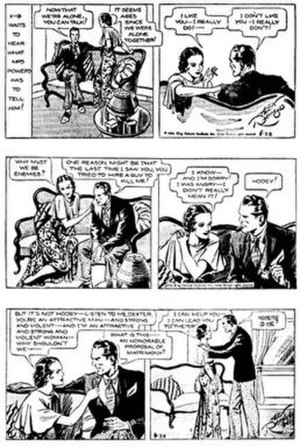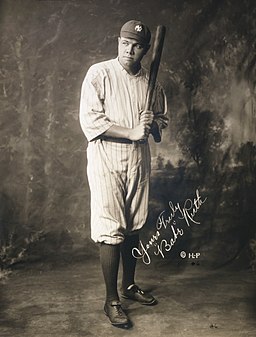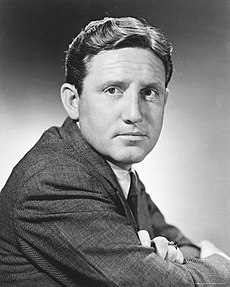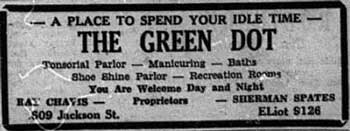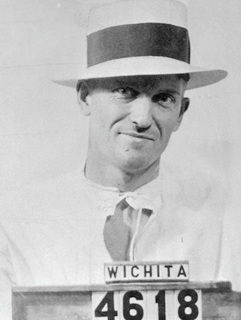Walked to school with Pauline. It was cold this morning. I paid my English fee for literature Monday.
The daily diary entries from Ruth Catherine McKenzie McCoy. Her daughter, author Fran Baker, has included photos, historic notes and "old-time" recipes following the entries. Readers are welcome to comment.
Tuesday, January 31, 2012
Monday, January 30, 2012
Tuesday, January 30, 1934
Pauline and I rode the streetcar. We are writing Morality Plays in Expression. Making a History scrapbook.
Sunday, January 29, 2012
Monday, January 29, 1934
Pauline and I rode the streetcar. It snowed last night. Sure was cold. I came home with Pauline.
 |
| Loula Long Combs (1881 - 1971) The daughter of Kansas City lumber baron, R.A. Long, Loula Long Combs and her husband, Robert Pryor Combs, lived at Longview Farm. For 65 years she competed in and won international horse shows in New York, Canada and England. She became known as the Queen of Kansas City's American Royal and is in the Madison Square Garden Hall of Fame. All of her prize-winning horses were raised and trained at Longview Farm, including her favorite, Revelation, whose grave marker is in fron of the Show Horse Arena. Toward the end of their lives, Loula and her sister Sally America Long Ellis donated the land for Longview Community College. Other parcels were sold and became Longview Lake, the second largest lake in Jackson County, Missouri. |
Saturday, January 28, 2012
Sunday, January 28, 1934
Went to Sunday School and church. In the evening Oliie and Mitchell were over. Sure was cold today.
Friday, January 27, 2012
Saturday, January 27, 1934
Mother and I got up early and went over to Aunt Katie’s and stayed all day. Went skating and to Helen’s school play.
 Child Labor Laffs - January 27, 1934 |
Flapper Fanny by Gladys ParkerGladys Parker was an American female comic artist of the 1920s and 1930s. She drew 'Gay and her Gang', a witty comic strip about the so-called "flappers": stylish, wise-cracking young women of the roaring twenties. She took over the one-panel cartoon 'Flapper Fanny' from Ethel Hays in 1932, and gave it a more cartoony style. At the same time, Ms. Parker drew a comic strip series for Lux soap. During the second World War, Gladys Parker came up with 'Mopsy', a girl who made her own contribution to the war effort by appearing as a nurse, soldier or engineer. 'Mopsy' ran from 1939 until 1965. Gladys Parker also took over the war-strip 'Flyin' Jenny' from Russell Keaton in 1942, until 1944, when his assistant Marc Swayze took over. |
Thursday, January 26, 2012
Friday, January 26, 1934
Walked to school with Pauline. Had History test. Practiced marching in gym. Walked home with Nadine and Pauline and Ruth R.
 The German–Polish Non-Aggression Pact Signed January 26, 1934 The German and Polish governments signed a non-agression pact which respected the two countries' borders for ten years. The pact provided Poland with some assurance that Germany would not attempt to recover the Polish corridor by military force. But as history reminds us, the pact was not to stand. On April 28, 1938, the Nazis removed Germany from it and on September 1, 1939, they invaded Poland (see photo above), putting aside any notion of peaceful and neighborly behavior. |
Wednesday, January 25, 2012
Thursday, January 25, 1934
Sure cold this morning. Pauline and I walked to school. I went up to Nadine’s in evening. Made candy. Wrote story for Ruth R.
 |
| 927 North Second Avenue Tucson, Arizona Rental house where John Dillinger was arrested on January 25, 1934 On January 15, 1934 while robbing a bank in Indiana, Dillinger was confronted by Officer William O’Malley, who shot him several times. Dillinger, who was wearing a bullet proof vest, was unharmed but in turn he allegedly shot and killed Officer O’Malley. Dillinger and his gang (Russell Clark, “Fat Charles” Makley, and “Handsome Harry” Pierpont) eventually made their way to Tucson, Arizona in January 1934. Dillinger rented a house located at 927 North Second Avenue. Gang members Clark and Makley checked into the Hotel Congress under aliases. On the night of January 22, 1934 a fire started in the basement of the hotel and spread up to the third floor. The desk clerk notified them of the fire and the two escaped by aerial ladders. As the story goes, Clark and Makley asked two firemen to retrieve their luggage. The luggage revealed their true identities and the fireman notified the Tucson Police Department. Dillinger and his gang were arrested at his house on January 25, 1934. |
Tuesday, January 24, 2012
Wednesday, January 24, 1934
I went up by for Pauline. Got to school pretty easily. Got cards yesterday. I got 10 points for semester grade.
 |
| January 24, 1934 - Jews are banned from the German Labor Front Here, Nazi storm troopers block the entrance to one of several Jewish-owned stores in Berlin. Their signs read: "Germans, defend yourselves against the Jewish atrocity propaganda, buy only at German shops!" and "Germans, defend yourselves, buy only at German shops!" |
Monday, January 23, 2012
Tuesday, January 23, 1934
Daddy took Pauline and I and Ruth Ray to school. Nadine didn’t go. In the evening Pauline and I walked home.
Ruth Elizabeth "Bette" Davis (April 5, 1908 - October 6, 1989)
Born in Lowell, Massachusetts, Davis was an actress in film, television and
theater. Davis was noted for her willingness to play unsympathetic characters.
She was highly regarded for her performances in a range of film genres, from
contemporary crime melodramas to historical and period films and occasional
comedies. Her greatest successes, however, were her roles in romantic dramas.
Davis gained a reputation as a perfectionist who could be highly combative, and
confrontations with studio executives, film directors and costars were often reported.
Her forthright manner, clipped vocal style and ubiquitous cigarette contributed to a public
persona which has often been imitated and satirized.
She was the co-founder of the Hollywood Canteen, and was the first female president
of the Academy of Motion Picture Arts and Sciences. She won the Academy Award
for Best Actress twice, was the first person to accrue 10 Academy Award nominations
for acting, and was the first woman to receive a Lifetime Achievement Award from the
American Film Institute.
Bette Davis died from breast cancer in France and is interred in Forest Lawn-Hollywood
Hills Cemetery in Los Angeles. On her tombstone is written: "She did it the hard way", an
epitaph that she mentioned in her memoir Mother Goddam as having been suggested to her
by Joseph L. Mankiewicz shortly after they had filmed All About Eve.
Sunday, January 22, 2012
Monday, January 22, 1934
Pauline and I walked to school. Only went till today. Ruth Ray and I walked to home at .
Saturday, January 21, 2012
Sunday, January 21, 1934
Mother and I went to Sunday School and church. Helped get dinner. Went over to Betty’s. Ollie was over at Mrs. Raifert’s. Went over and played pinochle.
 |
| Herman Perry (middle), a cofounder of Atlanta Citizens Trust Bank, discusses business with two patrons. January 21, 1934: Because of its sound operation, Atlanta Citizens Trust Bank became the first African American–owned bank to become a member of the Federal Deposit Insurance Corporation. In 1948 Citizens Trust became the first African American–owned bank to join the Federal Reserve Bank. |
Friday, January 20, 2012
Saturday, January 20, 1934
Slept kind of late. I went outside and played with Betty. In the p.m. I went up to Pauline’s. Played a little there.
Thursday, January 19, 2012
Wednesday, January 18, 2012
Thursday, January 18, 1934
Walked to school with Pauline. Walked home with Ruth Ray. Took Latin and English test. Ollie was over. R and N and I saw “Seth Parker.”
Tuesday, January 17, 2012
Wednesday, January 17, 1934
Walked to school with Pauline. Had my History and Expression examinations today. I got out at . Walked home with Ruth Ray.
Monday, January 16, 2012
Tuesday, January 16, 1934
Walked to school with Pauline. We met Lucille Flerharty again. Tomorrow is our examinations. Didn’t have any night work.
 |
| On January 16, 1934, five prisoners, including Raymond Hamilton (who was serving sentences totaling more than 200 years), were liberated from the Eastham State Prison Farm at Waldo, Texas by Clyde Barrow, accompanied by Bonnie Parker. Two guards were shot by the escaping prisoners with automatic pistols, which had been previously concealed in a ditch by Barrow. As the prisoners ran, Barrow covered their retreat with bursts of machine-gun fire. Among the escapees was Henry Methvin of Louisiana whose father, Ivan Methvin, helped arrange Bonnie and Clyde's deaths in 1934 at the hands of a posse headed by Texas lawman Frank Hamer. |
Sunday, January 15, 2012
Monday, January 15, 1934
Walked to school with Pauline. Ruth Ray and I waited for Nadine and Pauline and walked home with them.
Saturday, January 14, 2012
Sunday, January 14, 1934
Went to Sunday School and church. Daddy is still pretty sick. Had the doctor. Ollie was over. Played pinochle. She ate supper here.
Friday, January 13, 2012
Saturday, January 13, 1934
Aunt Kate’s were over. Went down to magazine shop. Got a magazine. Got some shoe polish. Polished my shoes.
![Screen Book Magazine [United States] (January 1934)](http://s12.bdbphotos.com/images/120x156/m/1/m1yayg43kqzgmg.jpg) |
| Katharine Houghton Hepburn (May 12, 1907 - June 29, 2003) Nicknames: First Lady of Cinema, Kate, The Great Kate After graduating from Bryn Mawr, Hepburn began getting small roles in plays on Broadway and elsewhere. She always attracted attention in these parts, especially for her role in "Art and Mrs. Bottle" (1931); then, she finally broke into stardom when she took the starring role of the Amazon princess Antiope in "A Warrior's Husband" (1932). The inevitable film offers followed, and after making a few screen tests, she was cast in "A Bill of Divorcement" (1932), opposite John Barrymore. The film was a hit, and after agreeing to her salary demands, RKO signed her to a contract. She made five films between 1932 and 1934. For her third, "Morning Glory" (1933) she won her first Academy Award. Her fourth, "Little Women" (1933) was the most successful picture of its day. But stories were beginning to leak out of her haughty behavior off- screen and her refusal to play the Hollywood Game, always wearing slacks and no makeup, never posing for pictures or giving interviews. Audiences were shocked at her unconventional behavior instead of applauding it, and so when she returned to Broadway in 1934 to star in "The Lake", the critics panned her and the audiences, who at first bought up tickets, soon deserted her. When she returned to Hollywood, things didn't get much better. From the period 1935-1938, she had only two hits: "Alice Adams" (1935), which brought her her second Oscar nomination, and "Stage Door" (1937). The many flops included "Break of Hearts" (1935), "Sylvia Scarlett" (1935), "Mary of Scotland" (1936), "Quality Street" (1937) and the now- classic "Bringing Up Baby" (1938). With so many flops, she came to be labeled "box-office poison." She decided to go back to Broadway to star in "The Philadelphia Story" (1938), and was rewarded with a smash. She quickly bought the film rights, and so was able to negotiate her way back to Hollywood on her own terms, including her choice of director and co-stars. The film version of "The Philadelphia Story" (1940) was a box-office hit, and Hepburn, who won her third Oscar nomination for the film, was bankable again. For her next film, "Woman of the Year" (1942), she was paired with Spencer Tracy, and the chemistry between them lasted for eight more films, spanning the course of 25 years, and a romance that lasted that long off-screen. (She received her fourth Oscar nomination for the film.) Their films included the very successful "Adam's Rib" (1949), "Pat and Mike" (1952), "Desk Set" (1957), and their final pairing in "Guess Who's Coming to Dinner (1967). |
Thursday, January 12, 2012
Friday, January 12, 1934
Walked with Pauline to school. I went swimming. Mrs. Raifert came over. Played pinochle. Mr. Mitchell came over.
 |
| King Prajadhipok (Rama VII) of Siam After a military coup challenged King Prajadhipok's (Rama VII) suspension of the constitution in 1933, and the failure of a counter-revolution in support of the royal government, the king departed on January 12, 1934, for a visit to Europe and did not return. The execution of the counter-revolutionary leaders led to King Prajadhipok's abdication in March 1935, in favor of his ten-year old nephew, Ananda Mahidol. The country was ruled by a Council of Regency, headed by Prince Aditya Dibabha. |
Wednesday, January 11, 2012
Thursday, January 11, 1934
Pauline and I walked to school. I had a Latin test. Saw Saw Meg Wynshink at the library. Helen’s was over this p.m.
Tuesday, January 10, 2012
Wednesday, January 10, 1934
Walked to school with Pauline and home. Mrs. Raifert came over. I called Aunt Kate. Daddy is still sick.
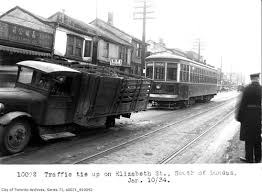 Toronto, Canada - January 10, 1934 |
| According to the City of Toronto Archives, the picture shows a "traffic tie up on Elizabeth Street south of Dundas with the truck having lost a rear wheel parked on tracks on Elizabeth Street delaying a Peter Witt streetcar on the Dundas route" on January 10, 1934. |
Monday, January 9, 2012
Tuesday, January 9, 1934
Walked to school with Pauline N. I waited for her at school. Daddy is sick in bed.
 |
60-INCH ANTI-AIRCRAFT SEARCHLIGHTJanuary 9, 1934: Sperry 60-inch anti-aircraft searchlight not so powerfulbut similar in almost every other respect to 800,000,000 c.p. lights ordered. Original Caption by Science Service ©Official U.S. Army Photograph [source Sperry Gyroscope Company] |
Sunday, January 8, 2012
Monday, January 8, 1934
Went to school today. I rode the street car. It snowed today. I went out sleigh riding.
Saturday, January 7, 2012
Sunday, January 7, 1934
Went to Sunday School and church. Daddy took us and brought us. Read the paper. In evening went over to Mrs. Raifert’s. Played cards. Ollie was over.
Friday, January 6, 2012
Saturday, January 6, 1934
I got up about . Went to Mary Hampton’s party. We had a taffy pull. Daddy came after me. Formed a club.
 |
| Taffy Pull Hook American Taffy Recipe 1/2 cup butter 2 cups white sugar 1 1/4 cups light corn syrup 1 1/2 cups water 1/8 teaspoon cream of tartar Melt butter; add sugar mixed with cream of tartar. Add remaining ingredients. Stir until sugar is dissolved. Cook to hard ball stage. Pour into greased platters. Butter hands and pull from one hand to another. (Or use a taffy pull hook if you have one.) Soon the taffy will become white. Pull into thin strips. Lay on greased surface. When hard, break into bite-size pieces and eat. YUM! 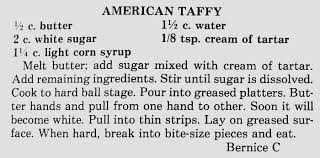 |
Thursday, January 5, 2012
Friday, January 5, 1934
Daddy took us girls to school. Went swimming. It snowed today a little. Finished my piece “Where There’s A Will There’s A Way.”
 |
| January 5, 1934: Both the National and American baseball leagues decided to use a uniform-size baseball. It was the first time in 33 years that both leagues used the same size ball. |
Wednesday, January 4, 2012
Thursday, January 4, 1934
Pauline and I rode to school today with her father. We had a test in English. Mr. Nesselroad came after us.
![Ziegfeld Follies of 1934 [Original Cast]. Original Cast Recording Ziegfeld Follies of 1934 [Original Cast]. Original Cast Recording](http://images-partners-tbn.google.com/images?q=tbn:ANd9GcRhoPggYX6GG7XpmnrJdLWb6QuHhLR4CVHNFvuDjakFogGN0YaU:images.slacker.com/covers/272/599343) | ||||||
| "Ziegfeld Follies of 1934" Premiered January 4, 1934 Winter Garden Theatre (1/4/1934 - 6/9/1934) Produced by Mrs. Florenz Ziegfeld, Jr.; (Uncredited) produced by Lee Shubert Music: various Lyrics: various Book: various Total Performances: 182 The Ziegfeld Follies were a series of elaborate theatrical productions on Broadway in New York City from 1907 through 1931. Inspired by the Folies Bergeres of Paris, the Ziegfeld Follies were conceived and mounted by Florenz Ziegfeld, reportedly at the suggestion of his then-wife, the entertainer Anna Held. The shows' producers were producing titans Klaw & Erlanger. |
Tuesday, January 3, 2012
Wednesday, January 3, 1934
Pauline and I walked to school today. Had swimming. Drew numbers for Expression. I am no. 6. Give them Thursday. Rode home on the streetcar.
| Ad from Ladies' Year Book - January 3, 1934 CABINET PUDDING* 6 oz. breadcrumbs. 1 pt. milk. 2 eggs. 1 tablespoon sugar. Grated lemon rind or nutmeg. 3 oz. currants (optional). Jam. Break the bread into a basin (a good use for odd pieces of bread or cake), and pour over the cold milk. Stir in the eggs well beaten, sugar, flavouring and currants. Leave to stand an hour or so. Put the jam into a greased basin, and pour in the mixture. Steam gently about 1 1/2 hours. *Named for any leftover bread or cake in your cabinet (AKA cupboard) |
Monday, January 2, 2012
Tuesday, January 2, 1934
I rode to school this a.m. on the street car. Had a lot of lessons this evening. Walked home by myself.
 |
| Aftermath of New Year's Day Flood in Los Angeles, California The 1934 flood disaster in Los Angeles basin was so horrific that Woody Guthrie composed a song called “Los Angeles New Year’s Flood” to memorialize the hundred people who were buried alive, drowned, or never found. Light rain began falling on December 30, 1933, and rapidly intensified to a downpour totaling 7.31 inches in 24 hours. This amount of rain qualified as the heaviest 24-hour rainfall yet documented (in 1934) by the local US Weather Bureau (rainfall measurement began in 1877). By midnight on December 31, 1933, the San Gabriel Mountains, towering above the Los Angeles basin, began to discharge massive debris flows of mud, rocks and trees down dozens of steep narrow canyons. The debris flows reached the basin floor as 20-foot walls of water, burying 200 houses and rendering another 400 uninhabitable. Also buried were around 800 mostly Model "A" cars in Montrose, La Crescenta and other foothill communities in the narrow La Canada Valley between the San Gabriel and Verdugo Mountains. Five people were killed at a New Year’s Eve party in a Montrose home buried by debris flow; ten bodies were pulled from a debris flow in La Crescenta; and 25 men, women, and children were drowned at the Red Cross headquarters at the American Legion Hall at Montrose Boulevard and La Crescenta when a wall of water tore open the building. The destruction was so complete that three years after the disaster, 45 persons remained unaccounted for. Ironically, the Los Angeles Times newspaper delivered a promotional insert on January 2, 1934, cheerfully describing the beauty of the foothill cities where “olive-canning and berry-raising” were the chief industries, and some of the most beautiful homes and estates in all Los Angeles were located. |
Sunday, January 1, 2012
Monday, January 1, 1934
Last nite we went over to Raiferts’s. Had a lunch. Played pinochle. There were nine of us there. Got home at
Subscribe to:
Posts (Atom)



